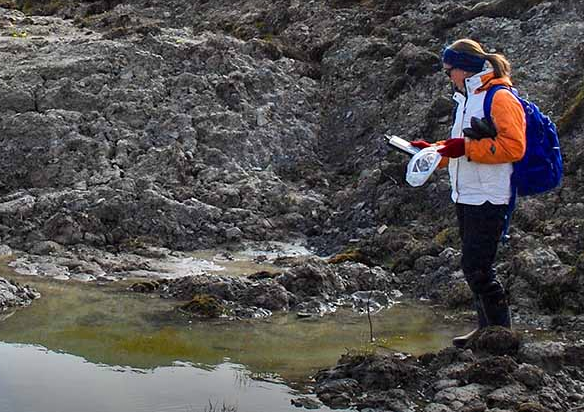Canadian research finds arctic ponds could be significant source of carbon emissions
- February 5, 2018
- Posted by: administrator
- Category: Environmental, Arctic & Antarctica, North America

A researcher collects data from a pond in the High Arctic near the Cape Bounty Arctic Watershed Observatory (photo courtesy of Melissa Lafrenière)
A new Canadian study involving researchers from the University of Toronto has found that carbon released by some ponds in the High Arctic could potentially be a hidden source of greenhouse gas emissions.
The study looked at how dissolved organic carbon (DOC) stored in Arctic permafrost – which is thawing at an accelerated rate due to climate change – is being released into Arctic watersheds as a result of physical disturbances that relocate nutrients across the landscape. For the first time, researchers were able to determine that the chemical composition of carbon in these ponds is vastly different than in rivers in the High Arctic.
“These ponds in the High Arctic seem to be hotspots for DOC degradation,” says Myrna Simpson, professor of environmental science at U of T Scarborough and co-author of the research.
“Very little consideration has been given to what’s happening with DOC in these ponds that are all over the Arctic, and it could potentially be a source of CO2 emissions released into the atmosphere with these disturbances.”
DOC – decomposed plant or animal material that dissolves by coming into contact with water is found everywhere – in lakes, oceans and in soil. In the High Arctic, DOC becomes mobile by entering watersheds, which is happening at an accelerated rate due to rapid permafrost thaw and the resulting change to the physical landscape.
When the DOC settles into ponds, it can be biodegraded by microbes more easily than in rivers, which means more carbon can get released into the atmosphere. While past studies have explored how active layer detachments have stimulated microbial activity in Arctic soil, this is the first to look mostly at water sources, including ponds.
Myrna Simpson continued:
“We didn’t measure how much carbon was being released because we didn’t expect to find this.”
“This is one of the novel findings of the study – that these ponds could play an important role in the global carbon cycle.”
Future lab and field experiments will be designed to figure out the processes responsible for gains or losses of carbon from the ponds, and also the process behind transforming carbon from one form to another.
Analysis of the DOC for the study was carried out in three different labs across Canada in order for researchers to use a host of sophisticated measurements.
The research, which is published in the journal Environmental Science and Technology, received funding from ArcticNet and the Natural Sciences and Engineering Research Council of Canada (NSERC).
